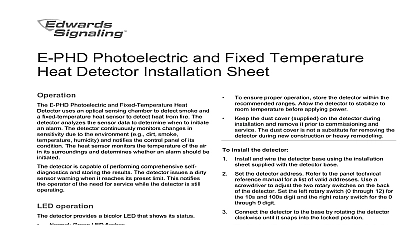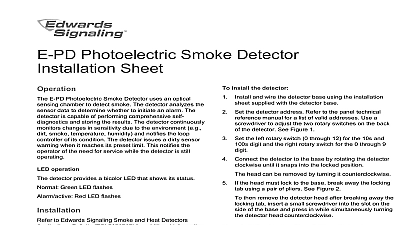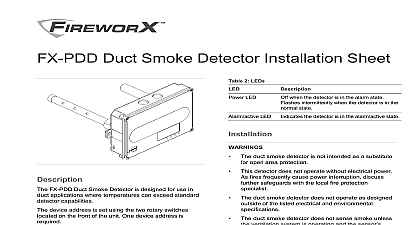Edwards E-HD Fixed-Temperature-Rate-of-Rise Heat Detector Installation Sheet

File Preview
Click below to download for free
Click below to download for free
File Data
| Name | edwards-e-hd-fixed-temperature-rate-of-rise-heat-detector-installation-sheet-6247183509.pdf |
|---|---|
| Type | |
| Size | 635.47 KB |
| Downloads |
Text Preview
Fixed Temperature Rate of Rise Heat Installation Sheet E HD Fixed Temperature Rate of Rise Heat Detector can configured as a rate of rise detector default or through as a fixed temperature heat detector When as a rate of rise detector a rate of rise heat sensor quickly detect a fast flaming fire When configured as a heat detector a fixed temperature heat monitors the temperature of the air in its surroundings determines whether to initiate an alarm The detector is of performing comprehensive self diagnostics and the results operation detector provides a bicolor LED that shows its status Green LED flashes Red LED flashes to Edwards Signaling Smoke and Heat Detector Bulletin P N 3101212 for additional information on placement and spacing detector does not operate without electrical power As frequently cause power interruption discuss further with the local fire protection specialist detector does not sense fires that start in areas heat cannot reach the detector Heat from fires in roofs or on the opposite side of closed doors may reach the detector detector is intended for use with ionization and or smoke detectors The heat detector by itself not provide life safety protection detector does not detect oxygen levels smoke toxic or flames Use this device only as part of a broad life safety program which includes a variety of sources pertaining to heat and smoke levels systems visual and audible devices and safety measures studies recommend using heat detectors only property protection Never rely on heat detectors as the means of fire protection ensure proper operation schedule maintenance or selected in accordance with the requirements the authority having jurisdiction Refer to NFPA 72 and ensure proper operation store the detector within the ranges Allow the detector to stabilize to temperature before applying power the dust cover supplied on the detector during and remove it prior to commissioning and The dust cover is not a substitute for removing the during new construction or heavy remodeling install the detector and wire the detector base using the installation supplied with the detector base Set the detector address Refer to the panel technical manual for a list of valid addresses a screwdriver to adjust the two rotary switches on the of the detector Set the left rotary switch 0 through for the 10s and 100s digit and the right rotary switch the 0 through 9 digit Connect the detector to the base by rotating the detector until it snaps into the locked position head can be removed by turning it counterclockwise the head must lock to the base break away the locking using a pair of pliers then remove the detector head after breaking away the tab insert a small screwdriver into the slot on the of the base and press in while simultaneously turning detector head counterclockwise 1 Setting detector address address 32 shown screwdriver here 2013 UTC Fire Security All rights reserved 2 3101209 REV 03 REB 28JAN13 2 Breakaway tab 6 4 5 9 Breakaway tab 72 and CAN ULC S537 require a calibrated sensitivity upon completion of the original installation and following modifications or additions to the system The detector can this test and generate a system sensitivity report test the detector Before initial testing remove the dust cover from the and notify the proper authorities that the fire system is undergoing maintenance and will be out of service Test the detector for proper operation using a heat gun a six inch minimum distance Use caution as heat can damage the detector and detector line voltage operating current current fixed temp alarm rating alarm point bases spacing distance from ceiling temperature environment 20 V peak to peak 57 to 140 54 to 60 8 B4U B4U LP RB4U IB4U SB4U ft 15 m centers in 305 mm to 140 to 60 to 120 0 to 49 to 93 RH noncondensing at 32 and compliance A Division of UTC Fire Security Corporation Inc Town Center Parkway Bradenton FL 34202 first two digits of the date code located on the identification label are the year of UL 521 CAN ULC S530 M91 NFPA 72 CAN ULC S524 of American information contact information see our Web site 2 3101209 REV 03 REB 28JAN13


